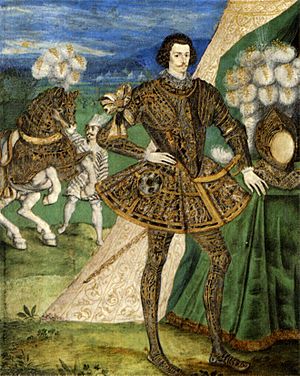Christopher Blount facts for kids
Quick facts for kids
Christopher Blount
|
|
|---|---|
| Born | 1555/1556 |
| Died | 18 March 1601 |
| Cause of death | Decapitation |
| Resting place | St. Peter ad Vincula, London |
| Nationality | English |
| Known for | Soldier and secret agent |
| Spouse(s) | Lettice Knollys |
| Parent(s) | Sir Thomas Blount Margery Poley |
Sir Christopher Blount (born around 1555 or 1556, died 18 March 1601) was an English soldier and a secret agent. He worked for a very important nobleman, Robert Dudley, 1st Earl of Leicester. Blount was a Catholic, and he even communicated with Mary, Queen of Scots's agent in Paris, Thomas Morgan.
After the Earl of Leicester passed away, Blount married the Earl's widow, Lettice Knollys. She was also the mother of Robert Devereux, 2nd Earl of Essex. Blount became a close friend and supporter of the Earl of Essex. He took part in the Earl's rebellion in February 1601. About five weeks later, he was executed in London for acting against the Queen.
Contents
Christopher Blount's Life and Work

Christopher Blount was born in Kidderminster, England. He was the younger son of Thomas Blount, who was a relative of the Earl of Leicester. Thomas Blount was also one of the Earl's main officers until he died in 1588.
Christopher's mother was Margery Poley. Her family, the Poleys, were strong Catholics. In contrast, the Blount family had adopted the new Protestant religion. As a child, Christopher Blount was sent to Louvain to be taught by William Allen.
Serving the Earl of Leicester
Even though he was Catholic, Christopher Blount became the "Gentleman of the Horse" for the Earl of Leicester by 1584. This was an important position in the Earl's household.
Blount also communicated with Thomas Morgan in Paris. Morgan was an agent for Mary, Queen of Scots, who was in exile. It seems Blount offered to help Mary. In these dealings, Blount likely had the support of both the Earl of Leicester and Francis Walsingham. Walsingham was Queen Elizabeth's spymaster.
The Earl of Leicester trusted Blount a lot. He even called him "Mr. Kytt" and cared about his well-being. Blount served in the Netherlands from 1585 to 1587. This was when Leicester was the Governor-General there, leading English forces.
Marriage and New Connections
In the spring of 1589, about seven months after the Earl of Leicester died, Blount married the Earl's widow, Lettice Knollys. Queen Elizabeth reportedly did not like Lettice because she had married the Earl of Leicester.
Lettice's son, Robert Devereux, 2nd Earl of Essex, was a new favorite of the Queen. He called his mother's marriage to Blount an "unhappy choice." However, Lettice seemed very happy with her decision, as her letters show. Lady Leicester, as she was still called, and Sir Christopher worked hard to pay off the Earl of Leicester's huge debts. They were involved in many legal cases because of this.
Political Role and Rebellion
Blount became a Member of Parliament for Staffordshire, where he lived. He served in Parliament in 1593 and 1597. He was elected because the Earl of Essex, who had a lot of influence in the county, insisted on it.
In 1596, Blount was a colonel in the Cádiz expedition, a military journey. In 1597, he took part in another expedition to the Azores. Blount was one of the main supporters of the Earl of Essex. He became deeply involved in the Earl's rebellion in 1601.
On Sunday, February 8, Blount tried to gather support in London. He rode alongside his stepson, the Earl of Essex, and was badly wounded in the cheek. After he was arrested, he was carried to his trial because he was still weak from his injury. He was executed about four weeks after the Earl of Essex on Tower Hill for acting against the Queen.

